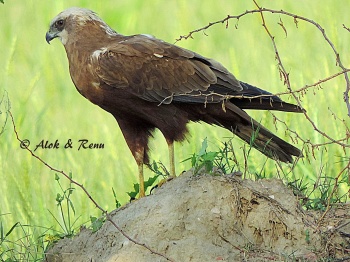Alternative name: Eurasian Marsh Harrier
- Circus aeruginosus
Identification
43–55 cm (17-21¾ in)
Male
- Yellowish-white head and breast
- Black wing tips
- rest of wing grey and brown
- Bluish-grey tail
- Brown belly
Female
- Brown overall plumage
- Cream crown, throat and leading edge wing
Similar Species
African Marsh Harrier and Eastern Marsh Harrier are the closest.
Distribution
Eurasia and north Africa. Widely distributed in the Western Palearctic region from Spain and northwest Africa, east across Russia to Central Asia and north to Scandinavia. It is extremely patchy across most of this area but there are small breeding populations in most countries of mainland Europe, as well as southern Britain, Sweden and Finland. Also breeds in Morocco, northern Algeria and Tunisia, and parts of Turkey and Iraq. Has begun a major expansion in northern Europe in recent decades after declining through persecution and loss of habitat. However, the species is still under pressure in parts of the Mediterranean, eastern Europe and the Middle East. Increasing in Britain with about 200 pairs present in 2000 from southeast England north to central Scotland.
Northern and eastern populations are migratory and winter in Africa and around the Mediterranean. Birds from Britain, France and Spain, and those from the eastern Mediterranean are resident or dispersive. A broad-front migrant but still appears at migration watchpoints in some numbers, particularly Gibraltar and Borçka. Wintering in central and eastern Europe is rare but does occur at Lake Neusiedl in Austria. Recorded as a vagrant in Iceland and the Faroes, Madeira and on the Azores.
Taxonomy

Photo © by Alok Tewari
Jamnagar, Coastal Gujarat, India, December-2017
A number of current species have in the past been seen as subspecies of Western Marsh Harrier: Eastern Marsh Harrier, Swamp Harrier, Reunion Harrier, Malagasy Harrier, African Marsh Harrier.
Subspecies
There are 2 subspecies[1]:
- C. a. aeruginosus:
- Breeds western and central Palearctic; winters in western and southern Europe, Africa (south to northern South Africa) and southern Asia.
- C. a. harterti:
Habitat
Breeds in reedbeds or other dense vegetation beside lakes, ponds and rivers or in marshes. Rarely, may nest in cornfields or heather. Hunts over water, reedbeds and adjacent farmland.
Behaviour
Diet
They prey on a wide variety of marsh birds and mammals. The diet includes birds' eggs, snakes, lizards, frogs, fish and insects.
Breeding
They generally nest in reed beds.
Vocalisation
References
- Clements, J. F., T. S. Schulenberg, M. J. Iliff, D. Roberson, T. A. Fredericks, B. L. Sullivan, and C. L. Wood. 2017. The eBird/Clements checklist of birds of the world: v2017, with updates to August 2017. Downloaded from http://www.birds.cornell.edu/clementschecklist/download/
- mlahanas.de Cyprus
- Handbook of the Birds of the World Alive (retrieved Feb 2018)
- Collins Bird Guide App
Recommended Citation
- BirdForum Opus contributors. (2024) Western Marsh Harrier. In: BirdForum, the forum for wild birds and birding. Retrieved 8 November 2024 from https://www.birdforum.net/opus/Western_Marsh_Harrier
External Links
GSearch checked for 2020 platform.1






